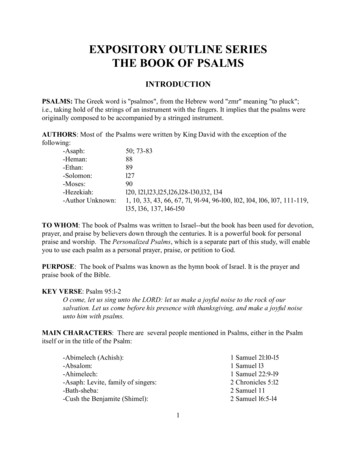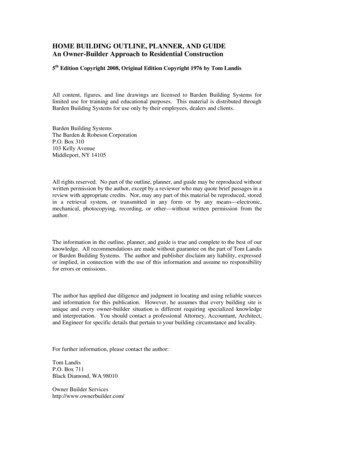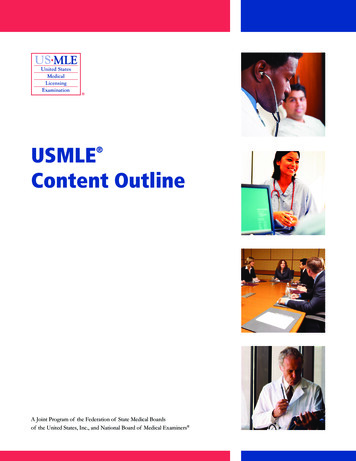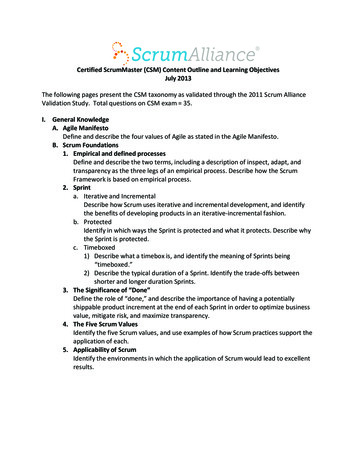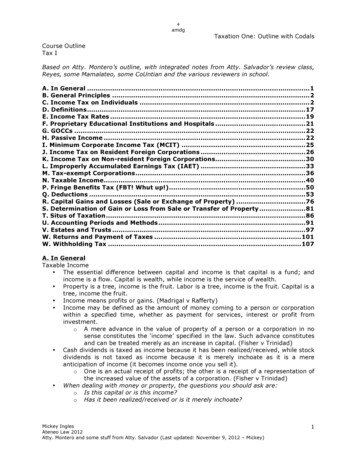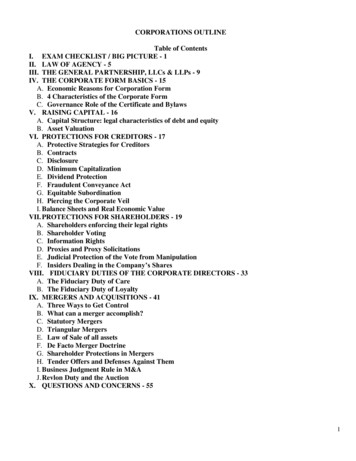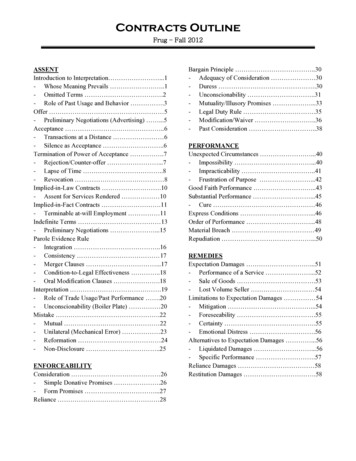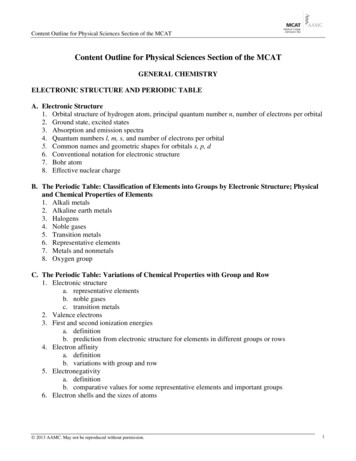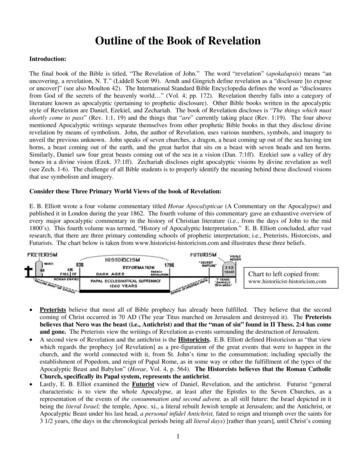
Transcription
Outline of the Book of RevelationIntroduction:The final book of the Bible is titled, “The Revelation of John.” The word “revelation” (apokalupsis) means “anuncovering, a revelation, N. T.” (Liddell Scott 99). Arndt and Gingrich define revelation as a “disclosure [to exposeor uncover]” (see also Moulton 42). The International Standard Bible Encyclopedia defines the word as “disclosuresfrom God of the secrets of the heavenly world ” (Vol. 4; pp. 172). Revelation thereby falls into a category ofliterature known as apocalyptic (pertaining to prophetic disclosure). Other Bible books written in the apocalypticstyle of Revelation are Daniel, Ezekiel, and Zechariah. The book of Revelation discloses is “The things which mustshortly come to pass” (Rev. 1:1, 19) and the things that “are” currently taking place (Rev. 1:19). The four abovementioned Apocalyptic writings separate themselves from other prophetic Bible books in that they disclose divinerevelation by means of symbolism. John, the author of Revelation, uses various numbers, symbols, and imagery tounveil the previous unknown. John speaks of seven churches, a dragon, a beast coming up out of the sea having tenhorns, a beast coming out of the earth, and the great harlot that sits on a beast with seven heads and ten horns.Similarly, Daniel saw four great beasts coming out of the sea in a vision (Dan. 7:1ff). Ezekiel saw a valley of drybones in a divine vision (Ezek. 37:1ff). Zechariah discloses eight apocalyptic visions by divine revelation as well(see Zech. 1-6). The challenge of all Bible students is to properly identify the meaning behind these disclosed visionsthat use symbolism and imagery.Consider these Three Primary World Views of the book of Revelation:E. B. Elliott wrote a four volume commentary titled Horae Apocalypticae (A Commentary on the Apocalypse) andpublished it in London during the year 1862. The fourth volume of this commentary gave an exhaustive overview ofevery major apocalyptic commentary in the history of Christian literature (i.e., from the days of John to the mid1800’s). This fourth volume was termed, “History of Apocalyptic Interpretation.” E. B. Elliott concluded, after vastresearch, that there are three primary contending schools of prophetic interpretation; i.e., Preterists, Historcists, andFuturists. The chart below is taken from www.historicist-historicism.com and illustrates these three beliefs.Chart to left copied from:www.historiicist-historicism.com Preterists believe that most all of Bible prophecy has already been fulfilled. They believe that the secondcoming of Christ occurred in 70 AD (The year Titus marched on Jerusalem and destroyed it). The Preteristsbelieves that Nero was the beast (i.e., Antichrist) and that the “man of sin” found in II Thess. 2:4 has comeand gone. The Preterists view the writings of Revelation as events surrounding the destruction of Jerusalem.A second view of Revelation and the antichrist is the Historicists. E.B. Elliott defined Historicism as “that viewwhich regards the prophecy [of Revelation] as a pre-figuration of the great events that were to happen in thechurch, and the world connected with it, from St. John’s time to the consummation; including specially theestablishment of Popedom, and reign of Papal Rome, as in some way or other the fulfillment of the types of theApocalyptic Beast and Babylon” (Horae, Vol. 4, p. 564). The Historcists believes that the Roman CatholicChurch, specifically its Papal system, represents the antichrist.Lastly, E. B. Elliot examined the Futurist view of Daniel, Revelation, and the antichrist. Futurist “generalcharacteristic is to view the whole Apocalypse, at least after the Epistles to the Seven Churches, as arepresentation of the events of the consummation and second advent, as all still future: the Israel depicted in itbeing the literal Israel; the temple, Apoc. xi., a literal rebuilt Jewish temple at Jerusalem; and the Antichrist, orApocalyptic Beast under his last head, a personal infidel Antichrist, fated to reign and triumph over the saints for3 1/2 years, (the days in the chronological periods being all literal days) [rather than years], until Christ’s coming1
shall destroy him” (Horae, Vol. 4, p. 597). Many Futurists teach premillenialism; i.e., the believe that therewill be a future rapture in which the saints of God will be taken from the earth. There will then follow sevenyears of tribulation and a battle of Armegeddon when Christ shall come again with his saints to defeat Satan andthe beast. Christ will then reign upon the earth for one thousand years. Futurists Hal Lindsey taught this in hisbest selling book, “The Late Great Planet Earth” as did Tim LaHaye in the very popular book series, “LeftBehind.”The fourth approach of the book of Revelation is not examined by Elliot and is the view that this study shall take.Let us refer to it as the Revelation (just as the book reads). We shall note that there is no antichrist such as Nero,the Roman Catholic church, or some future antichrist who would reign for 3 ½ years discussed in the book ofRevelation. Revelation is rather a book that instructs persecuted Christians to hang on to their faith because thewicked would soon be punished.The Right Approach to Understanding Apocalyptic LiteratureAbout twenty five non-canonical apocalyptic style literature books have been discovered. Our Bibles; however,reveal three apocalyptic books (as mentioned above) with small bits of this style of writing found in a few othercanonical books. As the word apocalyptic is defined above we immediately note that God intended for His readers tounderstand what is written; i.e., the veiled information is disclosed. The student of God’s word approaches all divinerevelation with the confidence of understanding, knowing, and practicing its principles (see John 8:32; I Cor. 14:33).When one sets out to read and understand Daniel, Ezekiel, Zechariah, and the book of Revelation he is challenged tocall upon all previous Bible knowledge of principles and terminology. A proper understanding of these books, likeany other Bible book, takes an approach of respect for God’s authorized word. We cannot be guilty of assigningmeanings to passages that neither the context nor the entirety of the Word of God supports. Apocalyptic style writingis difficult to understand not impossible. Apocalyptic literature ought to be approached no different than any otherbook in the Bible. We know God intends for us to understand it. It is up to us to put the time and extreme effort intoknowing its truths.Why Does God Reveal His Truths Through Veiled Language?The answer to this question can be found in the words of Jesus at Matthew 13:10ff. Jesus’ disciples had asked himwhy he spoke in parables and he answered, “Unto you it is given to know the mysteries of the kingdom of heaven, butto them it is not given.” (Matt. 13:11). The text reveals the fact that some had no true interest in God’s mysteries ofthe kingdom of heaven. Those who are interested will “desire to see” the meanings of these Biblical mysteries andthereby dig deep to find the treasure (Matt. 13:17). While apocalyptic and parable styles of writing are somewhatdifferent the principle remains equal. Mysteries are being revealed and those who desire to know will find themeaning.A word on InspirationRevelation often focuses on exposing what will happen before it happens so that the saint of God will not bediscouraged or dismayed but rather know that it is God’s will that these things take place (John 13:19; 14:29). Theauthor of Hebrews tells us that God communicated His message to man in “divers manners” (Heb. 1:1). Prophets ofGod saw divine visions and had divine dreams wherein God disclosed to the world His plans (see Obed. 1:1; Joel2:28ff; Amos 1:1). John and Ezekiel were “in the Spirit” when they were shown their apocalyptic visions (Rev. 1:10;Ezek. 37:1). Zechariah and Daniel saw by visions God’s revelations (Zech. 1:7ff; Dan. 7:1; 8:1; etc.). Nehemiahwrites, “Yet many years didst thou bear with them, and testified against them by thy Spirit through thy prophets”(Neh. 9:30 / cf. Ezek. 1:3; 11:4-7). The Apostle Peter tells us that God “moved” men to speak divine revelation bythe Holy Spirit (II Pet. 1:21). The Holy Spirit “entered into” (Ezek. 2:1-2) and “fell upon” (Ezek. 11:5) men causingthem to know and speak the mysteries of God. The Bible is clear. God’s objective is to reveal to man His will sothat there would remain no mysteries when it comes to our salvation. Whether one encounters apocalyptic, parabolic,or difficult text in general while studying the Bible always be aware that God intends for you and I to know thesetruths (Jn. 8:32; Eph. 3:3-4).2
Theme of Revelation:The thematic verse of Revelation is found in 17:14, “These shall war against the Lamb, and the Lamb shallovercome them, for he is Lord of lords, and Kings of kings; and they also shall overcome that are with him, calledand chosen and faithful.” Though this book was written to Christians under immense persecution, it is applicableto Christians of all ages. Like other epistles, Revelation should be read, studied and applied for all times (Cf. Col.4:16; I Thess. 5:27). Satan’s evil forces work just as hard today as they did then (cf. Rev. 17:12). The wordovercome or conquer (nikao, Gr.) is found seventeen times in the book of Revelation. This helps us understand thethrust of the book. The Christian can overcome in the face of the most formidable difficulties faced (Rev. 12:11;21:7). Comfort shall be found for those who wait on the promises of Jehovah (cf. Isa. 40:31). Revelation tells usthat the true elect will win the war against Satan with God's help.Date of writing:Conflict exists around dating the epistle. Some believe the account of Revelation was written during the days ofNero, A. D. 64 – 68, and others believe the time was A. D. 91 - 96 while Domitian served as the Roman Emperor.Though evidence exists for the early date, it seems more apparent that the later date is appropriate. Revelationdeals much with the persecution of the saints. During Nero’s days persecution occurred locally whereas during thedays of Domitian it was universal (some; however, deny this too). Whether early or late it really doesn't alter themeaning of the book. The following external and internal proof is given for the later date:External Evidence: The apostle Paul was in Roman prison with no apparent hostility to Christians from the Romans (AD 62 – 63).Nero is accused of setting fire to Rome July 10, AD 64. Nero, attempting to thwart the attention away from hisdeed, blames the Christians for the fire and they are persecuted locally.Paul is imprisoned a second time and suffers death AD 65 (Cf. II Tim. 4:6ff).Vespasian ruled as Emperor of Rome (AD 69 – 79).Titus, Vespasian’s son, besieged and conquered Jerusalem AD 70. Later, Titus succeeded his father Vespasianas Emperor of Rome for a short time (79 – 81 AD).Vespasian’s second son, Domitian, became emperor in AD 81 and ruled until AD 96. Domitian’s desire to beviewed as deity lead to many gross atrocities against society and Christians.o He proclaimed that Christianity was a crime against Rome.o Domitian persecuted Christians in and out of Rome.o Christians were exiled, put to death, tortured into a confession of the divinity of the emperor and some hadtheir property confiscated (Rev. 1:9; 13:15-17).o John receives the revelation to relay to the suffering Christians that they may be comforted.Internal Evidence: The apostle Paul wrote the church in Ephesus during the year AD 62. The state of the church appeared to begood. Paul commended the brethren of Ephesus, saying that he had heard of their faith and “the love which yeshow toward all the saints” (Eph. 1:15). However, in the Revelation account, Ephesus had obviously madespiritual changes for the worse. John wrote that they had “left their first love” (Rev. 2:4). The time isobviously different.Another proof of a latter date is found in Colossians. Paul had commended the Laodiceans by telling theColossians to “salute” them (Col. 4:15). No such commendation was given by the time Revelation was written.John had not one good thing to say about the Laodiceans in Revelation 3:14ff.Though much could be said and proved regarding both the early date and late date, it seems apparent to this writerthat the evidence for a late date outweighs the evidence for the early date. When the epistle was written, however,does not affect the marvelous words of encouragement in it.3
Numbers and Symbolism in Revelation:Apocalyptic literature, as discussed above, abounds in imagery and symbols to relay its message. Though there isnot one single direct quote from the OT found in Revelation, there are approximately four hundred allusions to OTterminology. A familiarity with the OT, therefore, is a must in looking into and understanding the book ofRevelation with its symbolism and numeric meaning. The interpretation of numbers is an important part ofunderstanding the book of Revelation. The numbers used in revelation are, for the most part, symbolically usedrather than literally. We know that there is no such thing as a dragon with seven heads; however, its symbolic useis effective in getting across a point. Likewise, the numbers of Revelation are not literal yet their purpose remainsthe same (i.e., to illustrate a point). The number seven appears to be the number that is mostly used throughout thebook. Seven represents something that is full or complete.Author of Revelation:The apostle John is apparently the author of Revelation. John addressed the seven churches of Asia in 1:4.Secondly, John used the first person singular pronoun “I” on several occasions (cf. 1:9-12 etc.). There is no doubtas to John the apostle being the author of this book.Overview of the book of Revelation:The book of Revelation begins, "The Revelation of Jesus Christ, which God gave him to show unto his servants,even the things which must shortly come to pass: and he sent and signified it by his angel unto his servant John"(Rev. 1:1). The Apostle John is commanded to write all that he sees, concerning the things that must shortly cometo pass, in a book and to send it to the seven churches of Asia (Rev. 1:11). Revelation reveals a panoramic pictureof events that have occurred, are currently occurring, and events that are to "shortly come to pass." This historicand futuristic panoramic picture depicts the unveiling of a seven sealed book that only the Lamb of God was worthyenough to loose and reveal its contents. One by one the seals were loosed and revealed the reaction of the gospelmessage being preached in the world. Many, due to their acceptance of the truth, were ill treated and even killed.Before the seventh seal was opened and its contents revealed there was silence for half an hour (Rev. 8:1).John saw seven angels with seven trumpets. The seven trumpets would sound one by one as humanity and theanimal kingdom experienced death and great woe (Rev. 8:13). Those not identified as the elect of God would betormented so that they might see their need to repent; however, the hardhearted sinners "repented not of the worksof their hands, that they should not worship demons, and the idols of gold, and of silver, and of brass, and of stone,and of wood; which can neither see, nor hear, nor walk: and they repented not of their murders, nor of theirsorceries, nor of their fornication, nor of their thefts" (Rev. 9:20-21). Jehovah had sent forth his prophets, apostles,and even His own son for man's salvation; however, man rejected His help and murdered the Lord's messengers(see Rev. 11:3ff). Their message tormented man because it exposed their shameful acts and demanded that they dothe very righteous acts that they were opposed to.The elect of God would not be spared by the wicked. Lurking in the shadows of darkness and filth is a beast that isidentified as a ferocious red dragon, enemy to all humanity, filled with crafty deceit, and identified as Satan (Rev.12:9). This ferocious beast had conquered the will of most of humanity with false religious teaching andworldliness (sexual immorality, lust for riches and pleasure of this world, vain glory, and pride - see I Timothy4:1ff; I Jn. 2:16-17; Rev. 13:7-8; 14:8). Satan's passionate hatred for the saints of God and His church depicts hiswill to destroy even the elect of God (see Rev. 12:17).Jehovah sends encouraging words to the saints dwelling upon the earth that are experiencing the onslaught ofpersecution, confusion of religious error, and the strong pull of worldliness (see Rev. 14:6 etc.). Jehovah reveals tothe world that He will pour out His fierce wrath upon those who give in to the wine of Satan (i.e., persecution, falseteaching, and worldliness) (see Rev. 14:9-10, 19-20). Jehovah's plea to man is that they would "overcome" theonslaught of the red dragon (see Rev. 2:7, 10 etc.). The book reveals the Lord's unwavering demand that His saints4
maintain nothing short of a perfect and godly life in order to receive His reward (see Rev. 2:4, 14, 20; 3:3, 15-16;18:4).God's mercy and forbearance is depicted once again in the pouring out of seven bowls of wrath upon the ungodlyyet their agony in the flesh was not enough to change their minds from a sin sick life. John writes, "and theyrepented not to give him glory. or of their works, but rather blasphemed God because of the plagues" (Rev. 16:9,10, 21). One of the seven angels that had one of the seven bowls of Jehovah's wrath showed John, in the spirit, thedemise of Rome and all other future powers that set themselves in array against God's divine will and purpose forman (see Rev. 17 all). One who takes a rebellious posture against Jehovah is destined for failure, misery, and greatanguish (see Rev. 17:14).Each generation of saints are called upon to remain sanctified from the filth of the world and have no fellowshipwith their unfruitful works of darkness (Rev. 18:4). Such sanctification and holiness will not come withoutgargantuan battles against our ancient foe the devil. He will bring his masses against the saints in every generationlikened unto Armageddon, Gog, and Magog (see Rev. 16:16; 19:19, 20:7ff). The Lord's true elect will always be inthe minority of those who refuse to be drunken with the wine of worldliness and false teaching. The message ofRevelation is that we would see what the world does not see. There are horrific eternal consequences to giving into Satan (see Rev. 20:10-15) and glorious rewards for the elect who overcome him (see Rev. 21-22). Christians ofevery generation should not drink the world's Kool-Aid of lust, vainglory, pride, and religious confusion (I Tim.4:1ff; I Jn. 2:16-17). While worldliness and false doctrines may have appear comforting and enjoyable at the end ithas a sting of eternal death. Know assuredly that God's promises are true. We too can overcome Satan's ferociousonslaught of wickedness if we would only keep God's commands come what may in this life!Chapter IPrelude:Revelation chapter one sets out to prove the validity of the message that John delivers to the seven churches ofAsia. Secondly, chapter one delivers an initial message of hope for the persecuted church. Thirdly, John reveals aheavenly vision of twelve parts. Chapter one reveals John’s commission to write down all that he sees that is andthat is to come. This first chapter reads as a mother who is speaking to her disheartened child with words of tenderencouragement. One may; however, look at Revelation chapter one as a general addressing his troops and tellingthem that even though the battle appears to be lost they will without a doubt prevail. The child and or troops haveno better recourse than to pick themselves up and move forward in the battle.I.Revelation Prologue / Words to Encourage the Downtrodden (1:1-3):A. “The Revelation of Jesus Christ, which God gave him to show unto his servants, even the things whichmust shortly come to pass: and he sent and signified it by his angel unto his servant John; who barewitness of the word of God, and of the testimony of Jesus Christ, even of all things that he saw”(1:1-2).1. The Godhead (Father, Jesus, Holy Spirit) is evidenced in the fact that “God” gave “Jesus” this“Revelation.” The word revelation (apokalupsis), as discussed in the introduction, means adisclosure or uncovering of that which was previously veiled or hidden from man.2. The information disclosed to the servants of God had to do with things that would “shortly come topass” and, as we shall see at verse 19 of this chapter, “things that are” occurring at the time of thiswriting. This disclosure to God’s servants was “signified” (semaino) “to shew by a sign,indicate, make known, point out; 2. absol. To give signs, make signals” (LS 727). The disclosedinformation handed from God to Jesus to his servants was signified (made known) by His angel.3. John, after receiving the revelation, bore witness to all that he saw and heard as is recorded in thisbook. The contents of Revelation are thereby of divine origin.B. “Blessed is he that reads, and they that hear the words of the prophecy, and keep the things that arewritten therein: for the time is at hand” (1:3).5
II.11. The word “blessed” (makarios) is the same Greek word found in the beatitudes (see Matt. 5:3-10).Makarios “happiness, those with good fortune” (LS 484). Those who would read the divinewords of Revelation, hear, and keep the laws therein are identified as happy and of good fortune.These encouraging words are a fit way to begin a book that reveals hope and encouragement forChristians who were being heavily persecuted and discouraged. There is hope and this revelationtells you about it!2. The reason for hope and encouragement during excruciating hard and trying times is that “the timeis at hand.” God has seen the tears of the saints as they loose loved ones and their property (seeRev. 7:17). The time when Christ would come again and bring home his saints to glory was “athand.” The author of Hebrews said, “and let us consider one another to provoke unto love andgood works; not forsaking our own assembling together, as the custom of some is, but exhortingone another; and so much the more, as ye see the day drawing nigh” (Heb. 10:24-25). Each daythat passes brings the day of Christ coming closer at hand. indeed it draws nigh.John Addresses the Seven Churches of Asia (1:4-8):A. “John to the seven churches that are in Asia: Grace to you and peace, from him who is and who wasand who is to come; and from the seven Spirits that are before his throne; and from Jesus Christ, whois the faithful witness, the firstborn of the dead, and the ruler of the kings of the earth. Unto him thatloves us, and loosed us from our sins by his blood and he made us to be a kingdom, to be priests untohis God and Father; to him be the glory and the dominion for ever and ever. Amen” (1:4-6).1. We are now introduced to the first use of numerical symbolism in the book of Revelation. Johnaddresses the seven churches that are in Asia (identified at Rev. 1:11). Why seven? “Seven is usedfor any round number, or for completeness, as we say a dozen, or as a speaker says he will say twoor three words.”1 It is apparent that when John speaks of the seven churches of Asia that he speaksof the universal church of Christ. Revelation 1:13 confirms this in that Christ is depicted as beingin the midst of the seven churches (He is in the midst of all the church as its head). Below aresome examples of the many times that we find the number seven in the scriptures.a. Jacob served seven years for Rachel (she then belonged to him) (Gen. 29:20).b. There were seven years of plenty and seven years of famine in Egypt (Gen. 41:53f).c. The Israelites marched seven days with seven priests blowing seven trumpets at Jericho(Josh. 6:8ff.).d. There were seven loaves to feed the four thousand and seven baskets to pass around the food(Matt. 15:34f).e. If the above explanation be true, the seven churches would certainly represent the whole ofGod’s church and the seven spirits would represent the completeness and perfectness of theHoly Spirit (revealer of divine truth) (Cf. Zech. 3:9 compared with Zech. 4:6, 10)!2. The scriptures teach that truth is to be established at the mouth of two or three witnesses (see Deut.19:15; Matt. 18:16; II Cor. 13:1). John reveals the threefold witnesses of Revelation to be God theFather (He that is, that was, and is to come – compare Ex. 3:14 where God tells Moses that He iscalled, “I AM.” The name I AM illustrates the eternal existence of God the Father), God the Son(Jesus Christ), and God the Holy Spirit (the seven spirits before the throne of God).3. John then reveals five things about Jesus before giving a doxology, “to him be the glory and thedominion for ever and ever. Amen” at verse 6.a. “Who is the faithful witness” (1:5). Again the word “witness” means testimony. Jesus gave anaccurate testimony of the things God told him (Jn. 3:32; 8:14; 18:37).b. “The firstborn from the dead” (1:5). Jesus was the first to die and be raised never to die again(I Cor. 15:20; Col. 1:18).c. “Ruler of the kings of the earth” (1:5). God had promised that his Son, Jesus, would be made“My firstborn, the highest of the kings of the earth” (Ps. 89:27). Jesus is indeed the potentateof all creation (see Acts 17:24).d. “Unto him that loveth us, and loosed us from our sins by his blood.” Without this lovingsacrifice, man could in no way have fellowship with God (I Jn. 1:5ff). Jesus set us free fromSmith, W. Smith’s Bible Dictionary pg. 6086
III.the bondage of sin (Matt. 26:28; Jn. 8:32). The cost of mankind’s redemption was the preciouslife blood of Jesus (Eph. 1:3-7). The word “loosed” (lusanti) (NM 956) “loosen, unbind,unfasten” (Moulton 255). Those who use the KJV Bible will find the word “washed” which issupported by the Strong’s Concordance. The thought is the same; i.e., forgiveness.e. He who “made us to be a kingdom, to be priests unto his God and Father.” All Christianswithin the universal church of Jesus Christ comprise a kingdom (Col. 4:11). Each member thatcomprises the kingdom of God is identified as a priest (see I Pet. 2:9). As God’s priests withinHis Kingdom, we make spiritual sacrifices unto the Lord (see Heb. 13:15).f. “To him be the glory and the dominion for ever and ever. Amen” (1:6). The word glory is“doxa” (Gr.) meaning “splendor, brightness; the kingly majesty which belongs to him as thesupreme ruler” (Rev. 1:6).” (Thayer 156). The fact that Jesus’ rule and kingdom (Dominion) isperpetuated into eternity brings to mind the fulfillment of Daniel’s prophecy in his dream (Dan.7:13). Daniel said of the Son of Man that “there was given him dominion, and glory and akingdom.” Isaiah said there would be no end of His kingdom (see Isa. 9:7). The Lord isworthy of such doxological statements.B. “Behold, he comes with the clouds; and every eye shall see him, and they that pierced him; and all thetribes of the earth shall mourn over him. Even so, Amen” (1:7).1. The phrase “cometh with the clouds” is to be comforting in two aspects. First, surely it includes thesecond coming of Jesus when he would bring his beloved and obedient saints home to glory (a restfrom their labor and hardships of this life) (see I Thess. 4:13ff).2. Secondly, the language is similar to passages in the OT that describe Jehovah’s wrath against theungodly of the day. Examples of this are found in (Isa. 19:1; Ezek. 30:3 etc.). This second thoughtgives comfort as well. The Romans, who were responsible for the current distress, will be judgedby God. These individuals will mourn for their foolish handling of the Savior of the world as allthe ungodly of all time will do (Jn. 12:44ff; II Thess. 1:6ff). Those who “pierced” the Lord and didnot repent at the preaching of men like Peter (see Acts 2:23).C. “I am the Alpha and the Omega, saith the Lord God, who is and who was and who is to come, theAlmighty” (1:8).1. The eternal existence of God is everywhere depicted in the Word of God (see Jn. 1:1ff; Eph. 1:3ff;etc.). God is the beginning and end and the one who is, was, and is to come it. He always has beenand he always will be.2. With the one true deity on the side of the saints who is it that shall move us to fear(see Rom. 8:31-39).John Explains why he is Writing this Revelation (1:9-16):A. “I John, your brother and partaker with you in the tribulation and kingdom and patience which are inJesus, was in the isle that is called Patmos, for the word of God and the testimony of Jesus” (1:9).1. John introduces himself to the seven churches (if the number seven represents perfection orcompleteness then John is really addressing the universal church of Christ). There are to be fourcommon denominators with all God’s priests:a. First, those of like precious faith who have obeyed the gospel have a wonderful connection andfellowship. So close is this fellowship that the Bible terms us brothers and sisters(see I Cor. 1:1-2).b. Secondly, John shared (was a fellow partaker) with the saints in “tribulation.” As statedbelow, secular history puts John on Patmos due to being exiled there by Rome. Tribulationwas and is the lot for all Christians and those who make it to heaven will not enter in by anyother means (see Acts 14:22).c. Thirdly, John shared in their common place as priests in the “Kingdom” of God. God’skingdom was the church here on earth. All those who obeyed the gospel were added to God’skingdom and recognized as its citizens (see Eph. 2:18-20).d. Fourthly, Christians are all connected together in our common struggle against evil and the factthat we are “patient” (i.e., our hope is in Christ and thereby we wait patiently for the fulfillmentof his promises). The prophet Isaiah wrote, “But they that wait upon the LORD shall renew7
their strength; they shall mount up with wings as eagles; they shall run, and n
best selling book, “The Late Great Planet Earth” as did Tim LaHaye in the very popular book series, “Left Behind.” The fourth approach of the book of Revelation is not examined by Elliot and is the view that this study shall take. Let u
